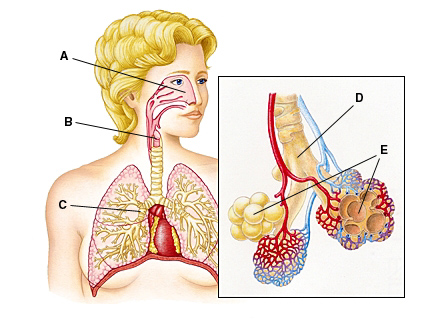Instructions for Side by Side Printing
- Print the notecards
- Fold each page in half along the solid vertical line
- Cut out the notecards by cutting along each horizontal dotted line
- Optional: Glue, tape or staple the ends of each notecard together
Biology 1 Chapter 42 Homework
front 1 In which of the following animals are the blood and the interstitial fluid considered to be the same body fluid? | back 1 grasshoppers |
front 2 Which of the following best describes an artery? | back 2 Arteries carry blood away from the heart. |
front 3 Organisms with a circulating body fluid that is distinct from the fluid that directly surrounds the body's cells are likely to have _____. | back 3 a closed circulatory system |
front 4 In an open circulatory system, hemolymph is _____. | back 4 not always confined to blood vessels and is under lower pressure than in closed circulatory systems |
front 5 Circulatory systems compensate for _____. | back 5 the slow rate at which diffusion occurs over large distances |
front 6 Blood returns to the heart via the _____. | back 6 pulmonary veins |
front 7 From the pulmonary veins, blood flows to the _____. | back 7 left atrium |
front 8 From the superior vena cava, blood flows to the _____. | back 8 right atrium |
front 9 From the capillaries of the abdominal organs and hind limbs, blood flows to the _____. | back 9 inferior vena cava |
front 10 Carbon dioxide enters the blood at the _____. | back 10 capillaries of the head, forelimbs, abdominal organs, and hind limbs |
front 11 The _____ has(have) the thinnest walls. | back 11 capillaries |
front 12 Blood pressure is highest in the _____. | back 12 aorta |
front 13  Most gas exchange with blood vessels occurs across the walls of the structure indicated by the letter _ | back 13 E (Gas exchange occurs across the walls of the alveoli) |
front 14 What is the function of a circulatory system? | back 14 It brings a transport liquid into close contact with all cells in the body. |
front 15 Why do the circulatory systems of land vertebrates have separate circuits to the lungs and to the rest of the body? | back 15 The large decrease in blood pressure as blood moves through the lungs may prevent efficient circulation through the rest of the body. |
front 16 True or false? The circulatory systems of land-dwelling vertebrates are composed of two pumping circuits: the systemic circulation, which is a lower-pressure circuit to the lung, and the pulmonary circulation, which is a higher-pressure circuit to the rest of the body. | back 16 False |
front 17 What is the function of the left ventricle? | back 17 The left ventricle receives oxygenated blood from the lungs and pumps it to the rest of the body. |
front 18 Which of the following statements about blood circulation in the body is true? | back 18 Valves prevent the backflow of blood into the atria and ventricles. |
front 19 Which event occurs first during diastole? | back 19 The atria and ventricles are relaxed, and blood flows into the atria |
front 20 Which event of the cardiac cycle occurs when systolic blood pressure is measured? | back 20 The ventricles contract, carrying blood into the aorta, and blood flows into the relaxed atria |
front 21 Which of the following develops the greatest pressure on the blood in the mammalian aorta? | back 21 systole of the left ventricle |
front 22 Which of the following is the correct sequence of blood flow in birds and mammals? | back 22 vena cava → right atrium → right ventricle pulmonary artery |
front 23 A patient with a blood pressure of 120/75, a pulse rate of 70 beats/minute, a stroke volume of 70 mL/beat (milliliters per beat), and a respiratory rate of 25 breaths/minute will have a cardiac output of _____. | back 23 4,900 mL/minute |
front 24 Damage to the sinoatrial node in humans _____. | back 24 would disrupt the rate and timing of cardiac muscle contractions |
front 25 If a molecule of carbon dioxide released into the blood in your left toe is exhaled from your nose, it must pass through all of the following EXCEPT _____. | back 25 the pulmonary vein |